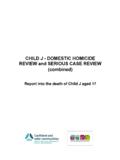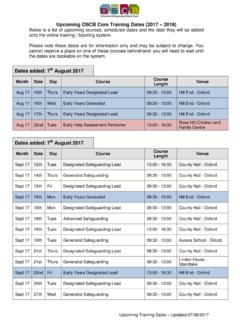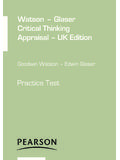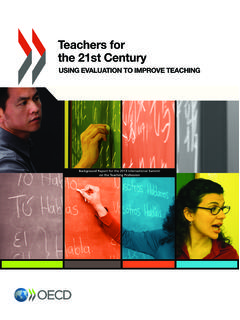Transcription of Keeping children safe in education - OSCB
1 Keeping children safe in education Statutory guidance for schools and colleges March 2015 2 Contents Summary 3 About this guidance 3 Who this guidance is for 3 What it replaces 4 Part one: Safeguarding information for all staff 5 What school and college staff should know and do 5 Types of abuse and neglect 10 Specific safeguarding issues 11 Part two: The management of safeguarding 14 The responsibility of governing bodies and proprietors 14 Part three: Safer recruitment 19 Recruitment, selection and pre-employment vetting 19 Types of check 22 Pre-appointment checks 23 Part four: Allegations of abuse made against teachers and other staff 36 Duties as an employer and an employee 36 Initial considerations 36 Supporting those involved 38 Managing the situation and exit arrangements 40 Specific actions 45 Annex A: Legislation 47 Annex B: Role of the designated safeguarding lead 48 Annex C: Special circumstances 50 Boarding schools and children s homes 50 children staying with host families 50 Annex D: Statutory guidance regulated activity ( children ) - Supervision of activity with children which is regulated activity when unsupervised.
2 52 Annex E: Disclosure and Barring Service checks 55 3 Summary About this guidance This is statutory guidance from the Department for education issued under Section 175 of the education Act 2002, the education (Independent school Standards) Regulations 2014 and the education (Non-Maintained Special Schools) (England) Regulations 2011. Schools and colleges must have regard to it when carrying out their duties to safeguard and promote the welfare of children . Unless otherwise specified, school means all schools whether maintained, non-maintained or independent schools, including academies and free schools, alternative provision academies and pupil referral units. school includes maintained nursery College means further education colleges and sixth-form colleges as established under the Further and Higher education Act 1992, and relates to their responsibilities towards children under the age of 18, but excludes 16-19 academies and free schools (which are required to comply with relevant safeguarding legislation by virtue of their funding agreement).
3 This document contains information on what schools and colleges should do and sets out the legal duties with which schools and colleges must comply. It should be read alongside statutory guidance Working Together to Safeguard children 2015 which applies to all the schools referred to above, and departmental advice What to do if you are worried a child is being abused 2015- Advice for practitioners. Legislation this guidance refers to is listed at Annex A. Who this guidance is for Governing bodies of maintained (including maintained nursery schools), non-maintained special schools, and colleges, proprietors of independent schools (including academies, free schools and alternative provision academies) and management committees of pupil referral units (PRUs), further education colleges and sixth form colleges. The above persons should ensure that all staff in schools and colleges read at least part one of this guidance.
4 1 The Early Years Foundation Stage Framework (EYFS) is mandatory for all early years providers. It applies to all schools that provide early years provision including maintained nursery schools. Maintained nursery schools, like the other schools listed, must have regard to Keeping children safe in education 2015 (by virtue of section 175(2) of the education Act 2002 see footnote 8 for further detail on this requirement). 4 What it replaces This guidance replaces Keeping children safe in education 2014, which replaced: Safeguarding children and Safer Recruitment in education (December 2006); and, Dealing with allegations of abuse made against teachers and other staff 2012. 5 Part one: Safeguarding information for all staff What school and college staff should know and do 1.
5 Safeguarding and promoting the welfare of children is defined for the purposes of this guidance as: protecting children from maltreatment; preventing impairment of children s health or development; ensuring that children grow up in circumstances consistent with the provision of safe and effective care; and taking action to enable all children to have the best outcomes. 2. children includes everyone under the age of 18. 3. Where a child is suffering significant harm, or is likely to do so, action should be taken to protect that Action should also be taken to promote the welfare of a child in need of additional support, even if they are not suffering harm or are at immediate The role of the school or college 4. Everyone who comes into contact with children and their families has a role to play in safeguarding children . school and college staff are particularly important as they are in a position to identify concerns early and provide help for children , to prevent concerns from escalating.
6 Schools and colleges and their staff form part of the wider safeguarding system for children . This system is described in statutory guidance Working Together to Safeguard children 2015. Schools and colleges should work with social care, the police, health services and other services to promote the welfare of children and protect them from harm. 5. Each school and college should have a designated safeguarding lead who will provide support to staff members to carry out their safeguarding duties and who will liaise closely with other services such as children s social care. The role of school and college staff 6. The Teachers Standards 2012 state that teachers, including headteachers, should safeguard children s wellbeing and maintain public trust in the teaching profession as part of their professional duties. 4 2 Such action might be taken under section 47 and section 44 of the children Act 1989.
7 3 Such action might be taken under section 17 of the children Act 1989. 4 The Teachers' Standards apply to: trainees working towards QTS; all teachers completing their statutory induction period (newly qualified teachers [NQTs]); and teachers in maintained schools, including maintained special schools, who are subject to the education ( school Teachers Appraisal) (England) Regulations 2012. 6 7. All school and college staff have a responsibility to provide a safe environment in which children can learn. 8. All school and college staff have a responsibility to identify children who may be in need of extra help or who are suffering, or are likely to suffer, significant harm. All staff then have a responsibility to take appropriate action, working with other services as needed. 9. In addition to working with the designated safeguarding lead staff members should be aware that they may be asked to support social workers to take decisions about individual children .
8 What school and college staff need to know 10. All staff members should be aware of systems within their school or college which support safeguarding and these should be explained to them as part of staff induction. This includes: the school s or college s child protection policy; the school s or college s staff behaviour policy (sometimes called a code of conduct); and the role of the designated safeguarding lead. 11. All staff members should also receive appropriate child protection training which is regularly updated. What school and college staff should look out for 12. All school and college staff members should be aware of the signs of abuse and neglect so that they are able to identify cases of children who may be in need of help or protection. 13. Staff members working with children are advised to maintain an attitude of it could happen here where safeguarding is concerned.
9 When concerned about the welfare of a child, staff members should always act in the interests of the child. 14. There are various expert sources of advice on the signs of abuse and neglect. Each area s Local Safeguarding children Board (LSCB) should be able to advise on useful material, including training One good source of advice is provided on the NSPCC website. Types of abuse and neglect, and examples of specific safeguarding issues, are described in paragraphs 24-29 of this guidance. 15. Knowing what to look for is vital to the early identification of abuse and neglect. If staff members are unsure they should always speak to the designated safeguarding lead. In exceptional circumstances, such as in emergency or a genuine concern that appropriate action has not been taken, staff members can speak directly to children s social care.
10 5 Department for education training materials on neglect. 7 16. A child going missing from education is a potential indicator of abuse or neglect. school and college staff members should follow the school s or college s procedures for dealing with children who go missing from education , particularly on repeat occasions, to help identify the risk of abuse and neglect including sexual abuse or exploitation and to help prevent the risks of their going missing in future. More information can be found in departmental advice about school attendance and statutory guidance about children who run away or go missing from home or care. What school and college staff should do if they have concerns about a child 17. If staff members have concerns about a child they should raise these with the school s or college s designated safeguarding lead.

















